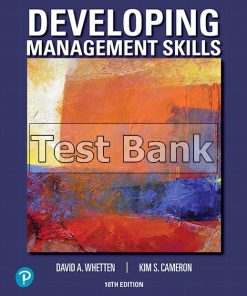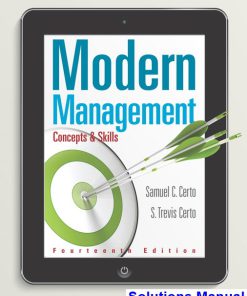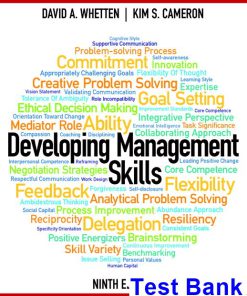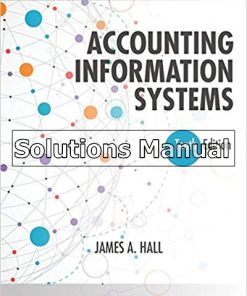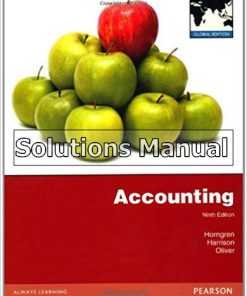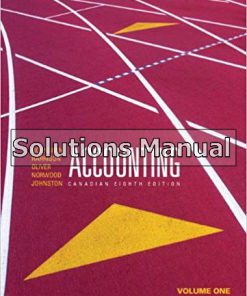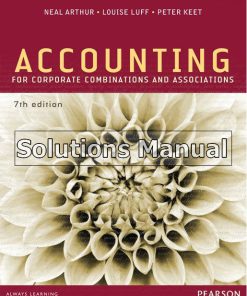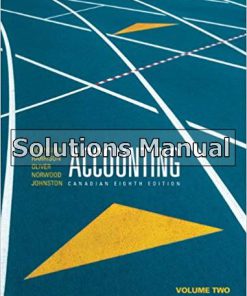Developing Management Skills 8th Edition Whetten Solutions Manual
$26.50$50.00 (-47%)
Developing Management Skills 8th Edition Whetten Solutions Manual.
You may also like
Developing Management Skills 8th Edition Whetten Solutions Manual

Product details:
- ISBN-10 : 9780136121008
- ISBN-13 : 978-0136121008
- Author: David Whetten
With an emphasis on self assessments, Developing Management Skillsgets readers involved in the learning experience, helping them connect the theories to their own lives. Further, this text focuses on developing the ten essential skills needed for success and gives readers tangible goals to work towards.
Based on suggestions from reviewers, instructors, and students, a number of changesincluding new skill-assessments and cases, and updated researchhave been incorporated in the eighth edition.
Table contents:
Introduction
1(2)
The Critical Role of Management Skills
3(41)
The Importance of Competent Managers
6(1)
The Skills of Effective Managers
7(1)
Essential Management Skills
8(1)
What Are Management Skills?
9(3)
Improving Management Skills
12(1)
An Approach to Skill Development
13(3)
Leadership and Management
16(2)
Contents of the Book
18(1)
Organization of the Book
19(2)
Practice and Application
21(1)
Diversity and Individual Differences
21(2)
Summary
23(1)
Supplementary Material
24(1)
Diagnostic Survey and Exercises
24(18)
Personal Assessment of Management Skills (PAMS)
24(4)
What Does It Take to Be an Effective Manager?
28(2)
SSS Software In-Basket Exercise
30(12)
Scoring Key and Comparison Data
42(1)
Personal Assessment of Management Skills
42(1)
Scoring Key
42(1)
Comparison Data
42(1)
What Does It Take to Be an Effective Manager?
43(1)
SSS Software In-Basket Exercise
43(1)
PART I PERSONAL SKILLS
44(188)
Developing Self-Awareness
45(60)
Skill Assessment
46(1)
Diagnostic Surveys for Scale Self-Awareness
46(11)
Self-Awareness Assessment
46(1)
Emotional Intelligence Assessment
47(1)
The Defining Issues Test
48(4)
Cognitive Style Indicator
52(1)
Locus of Control Scale
52(2)
Tolerance of Ambiguity Scale
54(2)
Core Self-Evaluation Scale (CSES)
56(1)
Skill Learning
57(1)
Key Dimensions of Self-Awareness
57(1)
The Enigma of Self-Awareness
58(2)
The Sensitive Line
58(2)
Understanding and Appreciating Individual Differences
60(1)
Important Areas of Self-Awareness
61(23)
Emotional Intelligence
62(3)
Values
65(7)
Ethical Decision Making and Values
72(2)
Cognitive Style
74(2)
Attitudes Toward Change
76(3)
Core Self-Evaluation
79(5)
Skill Analysis
84(1)
Cases Involving Self-Awareness
84(5)
Communist Prison Camp
84(1)
Computerized Exam
85(1)
Decision Dilemmas
86(3)
Skill Practice
89(1)
Exercises for Improving Self-Awareness Through Self-Disclosure
89(6)
Through the Looking Glass
89(1)
Diagnosing Managerial Characteristics
90(2)
An Exercise for Identifying Aspects of Personal Culture: A Learning Plan and Autobiography
92(3)
Skill Application
95(1)
Activities for Developing Self-Awareness
95(2)
Suggested Assignments
95(1)
Application Plan and Evaluation
95(2)
Scoring Keys and Comparison Data
97(1)
Self-Awareness Assessment
97(1)
Scoring Key
97(1)
Comparison Data
97(1)
Emotional Intelligence Assessment
97(2)
Scoring Key
97(2)
Comparison Data
99(1)
The Defining Issues Test
99(2)
The Escaped Prisoner
99(1)
The Doctor’s Dilemma
100(1)
The Newspaper
100(1)
Cognitive Style Indicator
101(1)
Scoring and Comparison Data for the Cognitive Style Indicator
101(1)
Scoring Key
101(1)
Comparison Data
101(1)
Locus of Control Scale
101(1)
Scoring Key
101(1)
Comparison Data
102(1)
Tolerance of Ambiguity Scale
102(1)
Scoring Key
102(1)
Comparison Data
102(1)
Core Self-Evaluation Scale
103(2)
Scoring Key
103(1)
Comparison Data
103(2)
Managing Personal Stress
105(62)
Skill Assessment
106(1)
Diagnostic Surveys for Managing Stress
106(6)
Stress Management Assessment
106(1)
Time Management Assessment
107(1)
Type A Personality Inventory
108(1)
Social Readjustment Rating Scale
109(2)
Sources of Personal Stress
111(1)
Skill Learning
112(1)
Improving the Management of Stress and Time
112(1)
The Role of Management
113(1)
Major Elements of Stress
113(4)
Reactions to Stress
114(1)
Coping with Stress
115(2)
Managing Stress
117(3)
Stressors
117(3)
Eliminating Stressors
120(14)
Eliminating Time Stressors Through Time Management
121(7)
Eliminating Encounter Stressors Through Collaboration and Emotional Intelligence
128(2)
Eliminating Situational Stressors Through Work Redesign
130(2)
Eliminating Anticipatory Stressors Through Prioritizing, Goal Setting, and Small Wins
132(2)
Developing Resiliency
134(10)
Physiological Resiliency
136(3)
Psychological Resiliency
139(4)
Social Resiliency
143(1)
Temporary Stress-Reduction Techniques
144(3)
Skill Analysis
147(1)
Cases Involving Stress Management
147(8)
The Turn of the Tide
147(3)
The Case of the Missing Time
150(5)
Skill Practice
155(1)
Exercises for Long-Term and Short-Run Stress Management
155(6)
The Small-Wins Strategy
155(1)
Life-Balance Analysis
156(2)
Deep Relaxation
158(1)
Monitoring and Managing Time
159(2)
Skill Application
161(1)
Activities for Managing Stress
161(1)
Suggested Assignments
161(1)
Application Plan and Evaluation
162(2)
Scoring Keys and Comparison Data
164(1)
Stress Management Assessment
164(1)
Scoring Key
164(1)
Comparison Data
164(1)
Time Management Assessment
164(1)
Scoring Key
164(1)
Comparison Data
165(1)
Type A Personality Inventory
165(1)
Scoring Key
165(1)
Comparison Data
165(1)
Social Readjustment Rating Scale
166(1)
Comparison Data
166(1)
Source of Personal Stress
166(1)
Solving Problems Analytically and Creatively
167(65)
Skill Assessment
168(1)
Diagnostic Surveys for Creative Problem Solving
168(6)
Problem Solving, Creativity, and Innovation
168(1)
How Creative Are You?
169(2)
Innovative Attitude Scale
171(1)
Creative Style Assessment
172(2)
Skill Learning
174(1)
Problem Solving, Creativity, and Innovation
174(1)
Steps in Analytical Problem Solving
174(4)
Defining the Problem
174(2)
Generating Alternatives
176(1)
Evaluating Alternatives
176(1)
Implementing the Solution
177(1)
Limitations of the Analytical Problem-Solving Model
178(1)
Impediments to Creative Problem Solving
178(1)
Multiple Approaches to Creativity
179(4)
Conceptual Blocks
183(11)
Percy Spencer’s Magnetron
185(1)
Spence Silver’s Glue
185(1)
The Four Types of Conceptual Blocks
185(9)
Review of Conceptual Blocks
194(1)
Conceptual Blockbusting
194(8)
Stages in Creative Thought
194(1)
Methods for Improving Problem Definition
195(4)
Ways to Generate More Alternatives
199(3)
International Caveats
202(1)
Hints for Applying Problem-Solving Techniques
203(1)
Fostering Creativity in Others
203(7)
Management Principles
204(6)
Skill Analysis
210(1)
Cases Involving Problem Solving
210(4)
The Mann Gulch Disaster
210(2)
Creativity at Apple
212(2)
Skill Practice
214(1)
Exercises for Applying Conceptual Blockbusting
214(8)
Individual Assignment—Analytical Problem Solving (10 minutes)
214(1)
Team Assignment—Creative Problem Solving (20 minutes)
215(1)
Moving Up in the Rankings
216(1)
Keith Dunn and McGuffey’s Restaurant
217(3)
Creative Problem-Solving Practice
220(2)
Skill Application
222(1)
Activities for Solving Problems Creatively
222(2)
Suggested Assignments
222(1)
Application Plan and Evaluation
222(2)
Scoring Keys and Comparison Data
224(1)
Problem Solving, Creativity, and Innovation
224(1)
Scoring Key
224(1)
Comparison Data
224(1)
How Creative Are You?
224(1)
Scoring Key
224(1)
Comparison Data
225(1)
Innovative Attitude Scale
225(1)
Scoring Key
225(1)
Creative Style Assessment
226(1)
Scoring Key
226(1)
Comparison Data
226(1)
Skill Practice Applying Conceptual Blockbusting
227(2)
Observer’s Feedback Form
227(2)
Answer to Matchstick Problem in Figure 3.4
229(1)
Answer to Shakespeare Riddle in Figure 3.5
229(1)
Some Common Themes Applying to Water and Finance
229(1)
Answer to Name That Ship Problem in Figure 3.6
230(1)
Answer to Nine-Dot Problem in Figure 3.7
230(1)
Answer to Embedded Pattern Problem in Figure 3.8
231(1)
PART II INTERPERSONAL SKILLS
232(206)
Building Relationships by Communicating Supportively
233(46)
Skill Assessment
234(1)
Diagnostic Surveys for Supportive Communication
234(4)
Communicating Supportively
234(1)
Communication Styles
235(3)
Skill Learning
238(1)
Building Positive Interpersonal Relationships
238(1)
The Importance of Effective Communication
239(3)
The Focus on Accuracy
240(2)
What Is Supportive Communication?
242(2)
Coaching and Counseling
244(3)
Coaching and Counseling Problems
245(1)
Defensiveness and Disconfirmation
246(1)
Principles of Supportive Communication
247(13)
Supportive Communication Is Based on Congruence, Not Incongruence
247(1)
Supportive Communication Is Descriptive, Not Evaluative
248(2)
Supportive Communication Is Problem-oriented, Not Person-oriented
250(1)
Supportive Communication Validates Rather than Invalidates Individuals
251(2)
Supportive Communication Is Specific (Useful), Not Global (Nonuseful)
253(1)
Supportive Communication Is Conjunctive, Not Disjunctive
254(1)
Supportive Communication Is Owned, Not Disowned
255(1)
Supportive Communication Requires Supportive Listening, Not One-Way Message Delivery
256(4)
The Personal Management Interview
260(3)
International Caveats
263(3)
Skill Analysis
266(1)
Cases Involving Building Positive Relationships
266(3)
Find Somebody Else
266(1)
Rejected Plans
267(2)
Skill Practice
269(1)
Exercises for Diagnosing Communication Problems and Fostering Understanding
269(5)
United Chemical Company
269(2)
Byron vs. Thomas
271(1)
Active Listening Exercise
272(2)
Skill Application
274(1)
Activities for Communicating Supportively
274(2)
Suggested Assignments
274(1)
Application Plan and Evaluation
274(2)
Scoring Keys and Comparison Data
276(1)
Communicating Supportively
276(1)
Scoring Key
276(1)
Comparison Data
276(1)
Communication Styles
276(2)
Comparison Data
276(2)
Skill Practice Diagnosing Problems and Fostering Understanding: United Chemical Company and Byron vs. Thomas
278(1)
Observer’s Feedback Form
278(1)
Gaining Power and Influence
279(44)
Skill Assessment
280(1)
Diagnostic Surveys for Gaining Power and Influence
280(3)
Gaining Power and Influence
280(1)
Using Influence Strategies
281(2)
Skill Learning
283(1)
Building a Strong Power Base and Using Influence Wisely
283(1)
A Balanced View of Power
283(3)
Lack of Power
283(2)
Abuse of Power
285(1)
Strategies for Gaining Organizational Power
286(12)
The Necessity of Power and Empowerment
286(2)
Sources of Personal Power
288(5)
Sources of Positional Power
293(5)
Transforming Power into Influence
298(12)
Influence Strategies: The Three Rs
298(2)
The Pros and Cons of Each Strategy
300(4)
Acting Assertively: Neutralizing Influence Attempts
304(6)
Skill Analysis
310(1)
Case Involving Power and Influence
310(1)
River Woods Plant Manager
310(1)
Skill Practice
311(1)
Exercise for Gaining Power
311(1)
Repairing Power Failures in Management Circuits
311(1)
Exercise for Using Influence Effectively
312(2)
Ann Lyman’s Proposal
313(1)
Exercises for Neutralizing Unwanted Influence Attempts
314(3)
Cindy’s Fast Foods
314(1)
9:00 to 7:30
315(2)
Skill Application
317(1)
Activities for Gaining Power and Influence
317(2)
Suggested Assignments
317(1)
Application Plan and Evaluation
318(1)
Scoring Keys and Comparison Data
319(1)
Gaining Power and Influence
319(1)
Scoring Key
319(1)
Comparison Data
320(1)
Using Influence Strategies
320(1)
Scoring Key
320(1)
Skill Practice Neutralizing Unwanted Influence Attempts
321(2)
Observer’s Feedback Form
321(2)
Motivating Others
323(50)
Skill Assessment
324(1)
Diagnostic Surveys for Motivating Others
324(2)
Diagnosing Poor Performance and Enhancing Motivation
324(1)
Work Performance Assessment
325(1)
Skill Learning
326(1)
Increasing Motivation and Performance
326(1)
Diagnosing Work Performance Problems
326(2)
Enhancing Individuals’ Abilities
328(2)
Fostering a Motivating Work Environment
330(1)
Elements of an Effective Motivation Program
331(23)
Establish Clear Performance Expectations
332(2)
Remove Obstacles to Performance
334(2)
Reinforce Performance-Enhancing Behavior
336(8)
Provide Salient Rewards
344(4)
Be Fair and Equitable
348(1)
Provide Timely Rewards and Accurate Feedback
348(6)
Skill Analysis
354(1)
Case Involving Motivation Problems
354(7)
Electro Logic
354(7)
Skill Practice
361(1)
Exercises for Diagnosing Work Performance Problems
361(3)
Joe Chaney
363(1)
Work Performance Assessment
364(1)
Exercise for Reshaping Unacceptable Behaviors
364(3)
Shaheen Matombo
364(3)
Skill Application
367(1)
Activities for Motivating Others
367(3)
Suggested Assignments
367(1)
Application Plan and Evaluation
368(2)
Scoring Keys and Comparison Data
370(1)
Diagnosing Poor Performance and Enhancing Motivation
370(1)
Scoring Key
370(1)
Comparison Data
370(1)
Work Performance
371(1)
Scoring Key
371(1)
Comparison Data
371(1)
Skill Practice Exercise for Reshaping Unacceptable Behaviors
372(1)
Observer’s Feedback Form
372(1)
Managing Conflict
373(65)
Skill Assessment
374(1)
Diagnostic Surveys for Managing Conflict
374(2)
Managing Interpersonal Conflict
374(1)
Strategies for Handling Conflict
375(1)
Skill Learning
376(1)
Interpersonal Conflict Management
376(2)
Mixed Feelings About Conflict
376(2)
Diagnosing the Type of Interpersonal Conflict
378(5)
Conflict Focus
378(2)
Conflict Source
380(3)
Selecting the Appropriate Conflict Management Approach
383(7)
Comparing Conflict Management and Negotiation Strategies
386(1)
Selection Factors
386(4)
Resolving Interpersonal Confrontations Using the Collaborative Approach
390(15)
A General Framework for Collaborative Problem Solving
391(1)
The Four Phases of Collaborative Problem Solving
392(13)
Skill Analysis
405(1)
Case Involving Interpersonal Conflict
405(5)
Educational Pension Investments
405(5)
Skill Practice
410(1)
Exercise for Diagnosing Sources of Conflict
410(8)
SSS Software Management Problems
410(8)
Exercises for Selecting an Appropriate Conflict Management Strategy
418(2)
Bradley’s Barn
419(1)
Avocado Computers
419(1)
Phelps, Inc.
420(1)
Exercises for Resolving Interpersonal Disputes
420(11)
Freida Mae Jones
421(2)
Can Larry Fit In?
423(1)
Meeting at Hartford Manufacturing Company
424(7)
Skill Application
431(1)
Activities for Improving Managing Conflict Skills
431(3)
Suggested Assignments
431(1)
Application Plan and Evaluation
432(2)
Scoring Keys and Comparison Data
434(1)
Managing Interpersonal Conflict
434(1)
Scoring Key
434(1)
Comparison Data
435(1)
Strategies for Handling Conflict
435(1)
Scoring Key
435(1)
Skill Practice Exercises for Resolving Interpersonal Disputes
436(2)
Observer’s Feedback Form
436(2)
PART III GROUP SKILLS
438(152)
Empowering and Delegating
439(50)
Skill Assessment
440(1)
Diagnostic Surveys for Empowering and Delegating
440(3)
Effective Empowerment and Delegation
440(1)
Personal Empowerment Assessment
441(2)
Skill Learning
443(1)
Empowering and Delegating
443(1)
A Management Dilemma Involving Empowerment
443(2)
The Dirty Dozen
444(1)
The Meaning of Empowerment
445(1)
Historical Roots of Empowerment
446(1)
Dimensions of Empowerment
447(4)
Self-Efficacy
447(1)
Self-Determination
448(1)
Personal Consequence
449(1)
Meaning
449(1)
Trust
450(1)
Review of Empowerment Dimensions
451(1)
How to Develop Empowerment
451(10)
Articulating a Clear Vision and Goals
452(1)
Fostering Personal Mastery Experiences
453(1)
Modeling
454(1)
Providing Support
454(1)
Emotional Arousal
455(1)
Providing Information
456(1)
Providing Resources
457(1)
Connecting to Outcomes
457(1)
Creating Confidence
458(1)
Review of Empowerment Principles
459(2)
Inhibitors to Empowerment
461(2)
Attitudes About Subordinates
462(1)
Personal Insecurities
462(1)
Need for Control
462(1)
Delegating Work
463(8)
Advantages of Empowered Delegation
463(1)
Deciding When to Delegate
464(1)
Deciding to Whom to Delegate
465(1)
Deciding How to Delegate Effectively
465(5)
Review of Delegation Principles
470(1)
International Caveats
471(3)
Skill Analysis
474(1)
Cases Involving Empowerment and Delegation
474(2)
Minding the Store
474(1)
Changing the Portfolio
475(1)
Skill Practice
476(1)
Exercises for Empowerment
476(7)
Executive Development Associates
476(4)
Empowering Ourselves
480(1)
Deciding to Delegate
481(2)
Skill Application
483(1)
Activities for Empowerment and Delegation
483(2)
Suggested Assignments
483(1)
Application Plan and Evaluation
483(2)
Scoring Keys and Comparison Data
485(1)
Effective Empowerment and Delegation
485(1)
Scoring Key
485(1)
Comparison Data
485(1)
Personal Empowerment
485(1)
Scoring Key
485(1)
Comparison Data
486(1)
Skill Practice Deciding to Delegate: Analysis of “An Emergency Request”
486(1)
Skill Practice Analysis of “Biological Warfare”
487(2)
Building Effective Teams and Teamwork
489(44)
Skill Assessment
490(1)
Diagnostic Surveys for Building Effective Teams
490(3)
Team Development Behaviors
490(1)
Diagnosing the Need for Team Building
491(2)
Skill Learning
493(1)
Developing Teams and Teamwork
493(1)
The Advantages of Teams
494(4)
An Example of an Effective Team
497(1)
Team Development
498(8)
The Forming Stage
498(1)
The Norming Stage
499(2)
The Storming Stage
501(2)
The Performing Stage
503(3)
Leading Teams
506(6)
Developing Credibility
507(2)
Establish Smart Goals and Everest Goals
509(2)
International Caveats
511(1)
Team Membership
512(7)
Advantageous Roles
512(4)
Providing Feedback
516(1)
International Caveats
517(2)
Skill Analysis
519(1)
Cases Involving Building Effective Teams
519(4)
The Tallahassee Democrat’s Elite Team
519(2)
The Cash Register Incident
521(2)
Skill Practice
523(1)
Exercises in Building Effective Teams
523(6)
Team Diagnosis and Team Development Exercise
523(1)
Winning the War on Talent
524(3)
Team Performance Exercise
527(2)
Skill Application
529(1)
Activities for Building Effective Teams
529(2)
Suggested Assignments
529(1)
Application Plan and Evaluation
530(1)
Scoring Keys and Comparison Data
531(1)
Team Development Behaviors
531(1)
Scoring Key
531(1)
Comparison Data
531(1)
Diagnosing the Need for Team Building
531(2)
Comparison Data
531(2)
Leading Positive Change
533(57)
Skill Assessment
534(1)
Diagnostic Surveys for Leading Positive Change
534(4)
Leading Positive Change
534(1)
Reflected Best-Self Feedback& Exercise
535(1)
A Sample E-Mail Request for Feedback
535(1)
Machiavellianism Scale—MACH IV
536(2)
Skill Learning
538(1)
Leading Positive Change
538(1)
Ubiquitous and Escalating Change
539(1)
The Need for Frameworks
539(1)
Tendencies Toward Stability
540(2)
A Framework for Leading Positive Change
542(26)
Establishing a Climate of Positivity
544(6)
Creating Readiness for Change
550(3)
Articulating a Vision of Abundance
553(4)
Generating Commitment to the Vision
557(5)
Institutionalizing the Positive Change
562(6)
Skill Analysis
568(1)
Cases Involving Leading Positive Change
568(13)
Corporate Vision Statements
568(6)
Lee Iacocca’s Transformation of Chrysler—1979-1984
574(7)
Skill Practice
581(1)
Exercises in Leading Positive Change
581(3)
Reflected Best-Self Portrait
581(1)
Positive Organizational Diagnosis Exercise
582(1)
A Positive Change Agenda
583(1)
Skill Application
584(1)
Activities for Leading Positive Change
584(3)
Suggested Assignments
584(1)
Application Plan and Evaluation
585(2)
Scoring Keys and Comparison Data
587(1)
Leading Positive Change Assessment
587(1)
Scoring Key
587(1)
Comparison Data
587(1)
Reflected Best-Self Feedback& Exercise
587(1)
Machiavellianism Scale—MACH IV
587(2)
Scoring Key
587(1)
Comparison Data
588(1)
Skill Analysis Iacocca’s Transformation of Chrysler—1979-1984
589(1)
PART IV SPECIFIC COMMUNICATION SKILLS
590(1)
Supplement A Making Oral and Written Presentations
591(28)
Skill Learning
592(1)
Making Oral and Written Presentations
592(1)
Essential Elements of Effective Presentations
593(16)
Skill Practice
609(1)
Exercises for Making Effective Oral and Written Presentations
609(10)
Speaking as a Leader
609(1)
Quality Circles at Battle Creek Foods
610(9)
Supplement B Conducting Interviews
619(32)
Skill Learning
620(1)
Planning and Conducting Interviews
620(9)
Specific Types of Organizational Interviews
629(5)
Skill Practice
634(17)
Exercises for Conducting Special-Purpose Interviews
634(1)
Evaluating the New Employee-Orientation Program
634(3)
Performance-Appraisal Interview with Chris Jakobsen
637(6)
Employment-Selection Interview at Smith Farley Insurance
643(8)
Supplement C Conducting Meetings
651(22)
Skill Learning
652(1)
Conducting Effective Meetings: A Short Guide for Meeting Managers and Meeting Participants
652(1)
The Five Ps of Effective Meetings
652(5)
Suggestions for Group Members
657(3)
Skill Practice
660(1)
Exercises for Conducting Meetings
660(13)
Preparing and Conducting a Team Meeting at SSS Software
660(1)
Role Diagnosis
660(1)
Meeting Evaluation Worksheet
661(12)
Appendix I Glossary
673(10)
Appendix II References
683(22)
Name Index
705(4)
Subject Index
709(4)
Combined Index
713
People also search:
developing management skills 10th edition pdf
developing management skills whetten
developing management skills
developing management skills 10th edition citation



